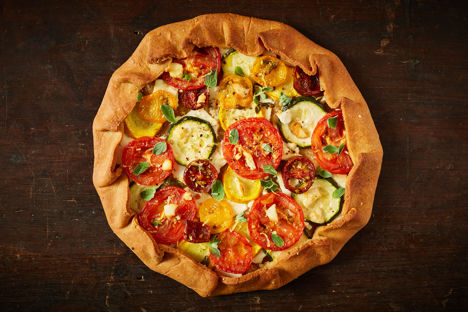
An ode to galettes: the flat cakes that took France by storm
Dating back to the eleventh century, galettes come in different shapes, sizes and flavours, evolving over the centuries into a variety of different (yet similar) dishes. We take a look at how this simple bake stood the test of time.
An ode to galettes: the flat cakes that took France by storm
Dating back to the eleventh century, galettes come in different shapes, sizes and flavours, evolving over the centuries into a variety of different (yet similar) dishes. We take a look at how this simple bake stood the test of time.
When it comes to pastries and cakes, the French have given the world more techniques, recipes and methods than anyone else. No other country has taken the simple combination of flour, dairy and heat to create such a varied range of delicious dishes, both sweet and savoury. Many were created in the nineteenth century – a golden age of French patisserie when classics such as the modern-day éclair and croissant first appeared – but others are much older, dating back a thousand years.
The galette is a perfect example of France’s time-honoured relationship with baking. Originating in Norman times – when it was known as a gale – the term simply refers to a ‘flat cake’. Over time (and depending on what part of France you’re in), it’s become a catchall term for a variety of different sweet and savoury bakes, all as delicious as each other. Some may be more well-known than others, but the one thing they have in common is that they’re flat, round and quintessentially French. Read on for a more in-depth look at the different types of galette, then try your hand at one of the accompanying recipes (be sure to use a top quality flour, such as Doves Farm, for the best results).
Galette
Let’s start off with the dish most people think of when discussing galettes. Essentially a freeform tart (some might say the French take on the Italian pizza), the standard galette sees a circle of pastry topped with a variety of thinly sliced ingredients. The sides of the pastry are then brought up around the filling – either carefully crimped for a fancier finish or simply pinched together for something more rustic – to create an open-topped tart that’s then baked until crisp. They can be sweet, often filled with fresh fruit, or savoury, featuring seasonal vegetables and plenty of melted cheese. It’s a popular bake as, unlike a pie, it allows the exposed filling to become caramelised in the oven. Savoury galettes often make the most of alternative flours – think Khorasan, rye or spelt (all made by Doves Farm) – as their nutty, earthy flavours complement the baked vegetables.
Galette Bretonne
In Brittany, a galette is a different thing entirely. Essentially a crepe (or pancake) made with buckwheat flour, it was a staple food in the region during the fourteenth and fifteenth centuries, as buckwheat was an easy, hardy crop to grow that was readily available. You’ll usually find it adorned with Emmental cheese, slices of ham and an egg (which is known as a galette complète in France), but any savoury filled buckwheat crepe is known as a galette Bretonne (or Breton galette) in France.
A slight variation on the galette Bretonne is the galette-saucisse, a handheld snack that’s particularly popular at football matches in the north of France. It’s a simple dish – nothing more than a pork sausage wrapped in a buckwheat pancake – making it perfect for eating whilst cheering your team on in the stadium.
Galette de rois
The most indulgent of all the galettes, the galette de rois (‘king cake’) ticks all the classical French boxes. Butter, sugar, cream, eggs and almonds create an incredibly rich filling to be sandwiched between sheets of puff pastry. It’s traditionally scored with a diamond pattern on top and served during the Epiphany in early January, which means there are plenty of festive traditions associated with it. The youngest child in the family has to hide under the table, telling the cake-cutter who to give each slice to. The baker will hide a charm in the galette de rois, and whoever finds it in their slice is named king or queen for the day, often wearing a crown and able to command the rest of the family to do their bidding.
The galette de rois is one of France’s most traditional festive bakes, and while many traditionalists swear by the original recipe, you’ll find more modern recipes include the likes of chocolate, fruit jams and chopped nuts. It’s quite a simple cake to create, but the flavour is incredibly rich and indulgent – perfect for rounding off the end of all that Christmas feasting.
Potato (and other vegetable) galettes
Today, the term ‘galette’ often refers to all sorts of dishes – not just those that are made with flour. Provided a dish is flat, round and French, there’s a good chance it’s been referred to as a galette at some point. The potato galette is a prime example of this – wafer-thin slices of potato are drenched in melted butter infused with thyme and garlic, then arranged into a circular pattern and baked until tender. You’ll find a similar style of galette made with courgettes, tomatoes and other thinly sliced vegetables – in this case, it’s a reference to the shape rather than the traditional Norman recipe.


